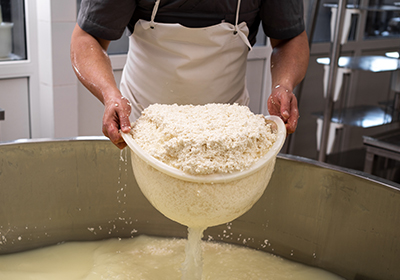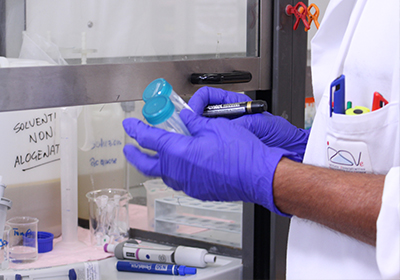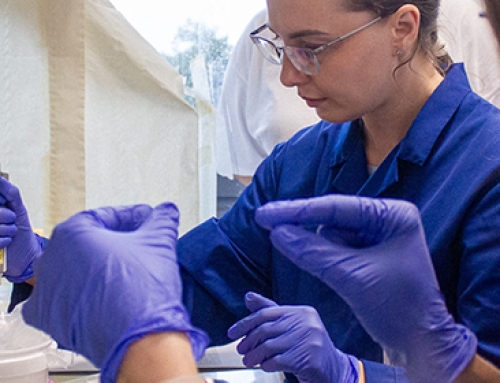Aflatoxins are mycotoxins produced by various species of Aspergillus fungi. They can be found in foods and animal feed and can consequently be transferred to milk and its derivatives. Animals such as lactating cattle, sheep, or goats exposed to feed contaminated by aflatoxin B1 can excrete the substance into their milk, through its metabolite, aflatoxin M1. This in turn can be transferred to humans through diet. The European Union has set a maximum limit of 0.050 μg/kg (a microgram is equivalent to a billionth of a kilo) for milk, but a single, specific limit has not been set for its derivatives, such as yogurt and cheese.
Assessing the level of aflatoxin contamination in a dairy product demands accurate, sensitive analytical methods. The researchers at the Chemistry Health Structure (SCS2) of the Istituto Zooprofilattico Sperimentale delle Venezie (IZSVe) have developed an innovative analytical method, based on liquid chromatography, for extracting and quantifying aflatoxin M1 in cheese, which is at once rapid, accurate and above all green. The work has been published in the journal, Food Control.
The problem of detecting aflatoxin M1 in cheese

During the cheese-making process, aflatoxin M1 present in milk can interact with the caseins and end up in variable concentrations in the curds.PAssessing the level of aflatoxin contamination in a dairy product demands accurate, sensitive analytical methods. While a standardized ISO method is available to determine aflatoxin M1 content in milk, this is not the case for cheese.
Why is defining the maximum limit of aflatoxin M1 in cheese an issue? And how can it be addressed? During the cheese-making process, aflatoxin M1 present in milk can interact with the caseins and end up in variable concentrations in the curds. This depends on many factors such as the type of cheese, its maturation level, the adopted technology, the production process applied, and others.
Given the lack of a single regulatory limit, it is up to food manufacturers to provide all the information about the product and the specific process applied, particularly in relation to specific concentration or dilution factors. The competent authority then utilizes these data to define the level of risk for consumers and therefore to determine product compliance with legal limits, when implementing official controls. However, whenever this information is incomplete, the risk can also be classified according to the parameters laid down by the National Committee for Food Safety (CNSA) (Opinion of the Italian Ministry of Health, 24 February, 2021).
To overcome the difficulties associated with the variability of available information and to strengthen the system of controlling aflatoxins, a set of reliable standard analytical methods designed to assess contamination levels – and thus correctly evaluate the risk – is highly warranted. Indeed, while a standardized ISO method is available to determine aflatoxin M1 content in milk, this is not the case for cheese.
The method developed by the IZSVe

IZSVe researchers developed an aqueous solution of sodium citrate, which has proven to be effective, with the added advantage of reducing the potential negative impact of toxic chemicals. The ambition is to develop a reference method for the national laboratory network, supported also by the partnership with the Italian Institute of Health and the National Reference Centre for Bovine Milk Quality (IZS of Lombardy and Emilia Romagna).
Over time, research groups have proposed several quantitative methods characterized by high sensitivity and, possibly, by limited use of toxic solvents for extraction or sample pre-treatment.
“Aflatoxin M1 is usually extracted from cheeses using organic, chlorinated solvents, which can be harmful to the environment and laboratory workers,” explains Giancarlo Biancotto, study supervisor and head of the Veterinary Pharmaceutical and Research Laboratory at IZSVe. “As an alternative, we have utilized an aqueous solution of sodium citrate, which has proven to be effective with the added advantage of reducing the potential negative impact of toxic chemicals.
This method has been internally validated for hard and soft cheeses and we are currently testing it as part of an interlaboratory trial to evaluate accuracy, sensitivity, and robustness, with very promising preliminary results. Our ambition is to develop a reference method for the national laboratory network, supported also by our partnership with the Italian Institute of Health and the National Reference Centre for Bovine Milk Quality of the IZS of Lombardy and Emilia Romagna.”
In the coming months it is planned to extend the study to assess concentration factors in a wider variety of cheese samples, starting from naturally contaminated milk, in the knowledge that an accurate, green method is available to quantify the presence of aflatoxin M1.
Read the scientific articole in Food Control »




![IZSVe at the First FAO Global Conference on animal health, vaccines, and sustainable livestock [Gallery]](https://www.izsvenezie.com/wp-content/uploads/2024/09/fao-global-conference-500x383.jpg)

